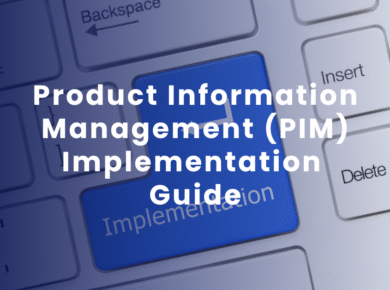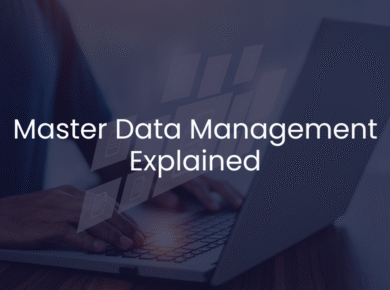Table of Contents Understanding the Essentials of PIM Implementation In the evolving
As digital transformation reshapes industries, data has emerged as the most strategic asset in enterprise growth. However, managing this ever-growing, diverse, and complex asset comes with its own set of challenges. With the rise of AI, machine learning, cloud-native platforms, and real-time analytics, organizations now have more powerful tools to address these data management hurdles.
In this post, we explore five key data management challenges faced by enterprises today and how modern technologies and strategies can solve them.
1. Growing Data Silos Across Distributed Environments
The Challenge: Organizations generate large volumes of data across multiple departments, platforms, and cloud environments. When this data is stored in isolated systems without interoperability, it leads to data silos, obstructing analytics, slowing down decision-making, and increasing operational inefficiencies.
The Solution: Modern data integration platforms often built with data fabric or data mesh architectures break down silos by enabling seamless data access across distributed systems. Solutions like a robust PIM platform allow businesses to unify structured and unstructured data in real time. Coupled with AI-powered ETL (Extract, Transform, Load) systems, these platforms standardize, cleanse, and synchronize data for a single source of truth.
2. Complex and Rigid Data Architectures
The Challenge: Legacy systems are often inflexible, making it difficult to scale or adapt to new business needs. Data flow across these systems tends to follow a waterfall model, which slows innovation and hinders agility.
The Solution: Enterprises are now shifting towards DataOps and microservices-based architectures. These approaches embrace modular, scalable, and flexible data pipelines that can be continuously optimized. Tools like Kubernetes, Apache Kafka, and event-driven architectures allow real-time data processing while promoting agility and collaboration between data engineers, analysts, and business users.
3. Insufficient Data Governance and Regulatory Compliance
The Challenge: As data privacy laws like GDPR, CCPA, and India’s DPDP Act become more stringent, organizations struggle to enforce consistent data governance across all touchpoints. Lack of clarity around data ownership, lineage, and quality leads to compliance risks and potential penalties.
The Solution: Modern data management platforms incorporate AI-based data cataloging, automated policy enforcement, and audit-ready reporting capabilities. These solutions offer data classification, lineage tracking, and role-based access controls. Leading platforms now integrate privacy-enhancing technologies (PETs) and automated data stewardship, allowing teams to balance accessibility with compliance.
4. Data Security and Privacy Threats in a Cloud-First World
The Challenge: With increasing reliance on cloud services and remote work environments, securing data across hybrid and multi-cloud infrastructures is a growing concern. Cyber threats, insider risks, and data breaches can lead to financial and reputational damage.
The Solution: A multi-layered Zero Trust architecture (ZTA) is now considered essential. Organizations are adopting AI-driven threat detection, encryption at rest and in transit, and data masking to protect sensitive information. ML-based anomaly detection systems can proactively identify suspicious behavior. Additionally, automated incident response systems minimize damage during potential breaches.
5. Navigating the Complexity of the Modern Data Ecosystem
The Challenge: Today’s data ecosystem includes IoT devices, cloud apps, third-party data feeds, and edge computing—each with its own data standards and protocols. Managing such a diverse and dynamic environment is a monumental task.
The Solution: Smart orchestration of this ecosystem is possible through AI-powered metadata management, semantic data modeling, and interoperability frameworks. Natural Language Processing (NLP) and Generative AI further enhance accessibility, allowing business users to interact with data via conversational interfaces. Meanwhile, ML algorithms continuously optimize pipelines, detect anomalies, and automate redundant processes—drastically reducing manual intervention.
Conclusion: Future-Ready Data Management is AI-Powered
As enterprises continue to scale, data will remain a critical enabler of business agility, innovation, and customer satisfaction. The convergence of AI, ML, automation, and cloud-native platforms is redefining how organizations approach data management. Investing in these capabilities today ensures not only regulatory compliance and operational efficiency but also a sustainable competitive advantage.
Modern data management isn’t just about storing information, it’s about unlocking its potential intelligently, securely, and responsibly.
Ready to overcome your data management challenges and future-proof your enterprise? Talk to our experts today.
Latest Resources
Questions to Ask When Choosing a PIM Vendor? - Part 2 Read
Questions to Ask When Choosing a PIM Vendor? - Part 1 Read
Choosing the Right Master Data Management Implementation Style for Your Business Read
Table of Contents Overview In the age of connected systems and customer-centric
How Social Commerce Is Driving the Need for Smarter PIM Systems? Read
How GenAI Is Redefining PIM and MDM in 2025? Read Blog From
5 Data Management Challenges and Modern Solutions for the AI Era Read
Table of Contents 1. IntroductionIn today’s data-driven digital economy, the integration of
Simplifying Your PIM Migration Journey: When, Why, and How to Make the









